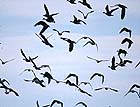Autumn Migration
The Baltic Island of Oland is one of the finest places in Europe to watch birds on the move, says David Tomlinson who marvelled at the copious quantities of robins and goldcrests in flight during his last trip.


Last October, I spent a week on the Baltic Island of Oland watching the autumn migration. Oland is one of thebest places in Europe to see birds on the move, as it provides a stepping stone between the tundra and the taiga of northern and Continental Europe.
Most spectacular of all the migrants were thebarnacle geese. After a couple of days when scores of thousands of had passed through, it was difficult to believe that there could be many more to follow, but still they came in great, noisy skeins. Many birds of prey were also migrating, and as soon as the days warmed, dozens of rough-legged buzzards soared up from the Ottenby woods.
However, it was neither buzzards nor barnacles that left the most lasting impression, but robins andgoldcrests. For the few days,there were robins everywhere on the island. These were birds from the forests of Finland and Russia, heading for wintering grounds in southern Europe. In contrast, most British robins are sedentary, and seldom move far.
By the end of the week, there was hardly a robin to be seen. Their place had been taken by goldcrests, whose thin, high-pitched contact calls could be heard constantly, even if the birds themselves were often invisible. At only 9cm long,goldcrests are Europe's smallest bird, and these fat, autumn migrants weigh in at 5.5gm.
Such tiny birds are unlikely long-distance travellers, but these individuals had already covered hundreds of miles, and still had far to go. At this time every autumn,thousands of goldcrests cross the North Sea and arrive on our East Coast, where they linger for a few days before dispersing inland. Whether any of these birds have passed through Oland is a mystery, but there is a fair chance that some will have done so.
This article first appeared in Country Life magazine.
Exquisite houses, the beauty of Nature, and how to get the most from your life, straight to your inbox.
Country Life is unlike any other magazine: the only glossy weekly on the newsstand and the only magazine that has been guest-edited by His Majesty The King not once, but twice. It is a celebration of modern rural life and all its diverse joys and pleasures — that was first published in Queen Victoria's Diamond Jubilee year. Our eclectic mixture of witty and informative content — from the most up-to-date property news and commentary and a coveted glimpse inside some of the UK's best houses and gardens, to gardening, the arts and interior design, written by experts in their field — still cannot be found in print or online, anywhere else.
